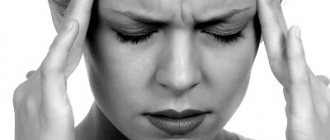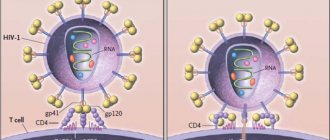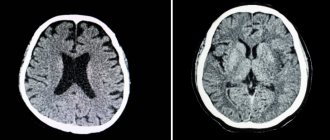Pain or discomfort has an obvious cause: a blow, a cut, muscle overload. But sometimes unpleasant sensations arise in the absence of external influences. Then we can talk about neuropathy - damage to one or more peripheral nerves of a non-inflammatory nature.
Peripheral nerves include all those located outside the brain and spinal cord. They form a wide network, regulate the functioning of internal organs and muscle contraction. Therefore, when neuropathy occurs, a large number of symptoms are formed, which are sometimes mistakenly mistaken for the pathology of a certain organ. But treatment will be ineffective if the cause of the disorders is not established and methods of complex nerve therapy are not used.
Types of neuropathy
The types of neuropathy are determined depending on the number of nerves affected. If only one nerve is involved in the pathological process, they speak of mononeuropathy. This type of disease, compression-ischemic neuropathy, most often occurs in large nerve trunks - the femoral, sciatic, trigeminal or radiocarpal nerve. The pathology is relatively easy to diagnose; symptoms appear in the direction of the location of the nerve trunk in the tissues.
Another type is ischemic neuropathy, but it only affects the optic nerve. In fact, this is his heart attack, leading to a decrease in visual acuity, even to blindness. Separately, there is post-traumatic neuropathy, which occurs as a result of a fracture, compression of a limb, sprain or other injuries.
With polyneuropathy, entire groups of peripheral nerves are affected. The disease can occur simultaneously in several limbs, often symmetrically on different halves of the body, and is accompanied by a large number of symptoms. Depending on the causes, the following types of polyneuropathy are distinguished:
- metabolic – occur due to metabolic disorders, there are diabetic, uremic, hepatic;
- infectious-toxic – develop due to viral diseases (AIDS, leprosy, Lyme disease);
- toxic - nerve fibers are damaged by poisons, heavy metals, alcohol, possible with an overdose of medications;
- hereditary - it includes inherited genetic diseases and syndromes: Refsum's disease, Roussy-Levi syndrome, Charcot-Marie-Tutte amyotrophy;
- nutritional – occur in people with malnutrition and a deficiency of certain vitamins;
- autoimmune - are formed when the immune system attacks its own nerve fibers, these include Miller-Flesher syndrome, paraneoplastic neuropathies in cancer, paraproteinemic polyneuropathies.
Neuropathies are divided into several types, depending on the nature of the damage to the nerve trunk. They can be axonal, when the inner part of the nerve is damaged, and demyelinating, in which the sheath is destroyed and the transmission of the nerve impulse is disrupted.
Treatment of alcoholic encephalopathy
A person affected by alcoholic encephalopathy should undergo treatment in an inpatient drug treatment clinic, where experienced specialists will be next to him. Treatment is quite complex; complex therapy is often performed. Treatment is the same as for acute delirium tremens. When treating this disease, the medications described below are used:
- Drugs that will help regulate metabolism in the body. In particular, antioxidants and amino acid preparations are used. For this purpose, ascorbic acid, glucose, thiamine and other vitamins are prescribed. Nandrolone is used to regulate metabolism;
- Drugs that improve cerebral circulation and eliminate disorders of liquorodynamics. In this case, antispasmodics are prescribed, for example, papaverine hydrochloride and others;
- Medicines that stimulate the central nervous system. As a rule, medications are used whose main active ingredient is caffeine;
- Antiallergenic medications. The most commonly used are chloropyramine and diphenhydramine;
- Nootropic drugs, for example, piracetam;
- Anticonvulsants. You can use, for example, aminalon;
- Complex vitamins. Vitamins of different groups are used. The dosage is selected depending on the severity of the disease and the patient’s condition.
It must be remembered that an important condition for a favorable outcome of the disease is timely seeking qualified medical help.
Causes of the disease
Patients do not always seek help in a timely manner. The reason for this is the numerous misconceptions associated with this disease. So, many are sure that causeless pain will go away on its own. But this is not true; over time, the pathology progresses and treatment becomes more difficult.
The cause of nerve dysfunction is several factors at the same time. In diabetes, damage occurs due to impaired blood supply and metabolism in the nerve tissue, the formation of edema and compression, and the synthesis of antibodies to the membrane of the nerve trunks. As a result, they atrophy and lead to the appearance of pathology.
Toxic and infectious lesions are also associated with the destruction of the outer sheath of nerve fibers. With alcoholism, vitamin B12 deficiency, excess B6 and nutritional disorders, small peripheral nerve processes - axons - are primarily destroyed, which causes loss of sensitivity in the hands or feet.
Vascular atherosclerosis, thrombosis of small capillaries, together with metabolic disorders, also cause neuropathy. This type of damage affects the optic nerve. In pregnant women, polyneuropathy is associated with the production of antibodies, disruption of nerve nutrition and toxic damage from their own metabolic products.
Hereditary neuropathies are characterized by genetic disorders that lead to changes in metabolism and the accumulation of toxic substances in tissues. They damage the myelin sheath of the nerve. In some cases, a hereditary disease leads to gradual atrophy of groups of nerves and severe motor and sensory disorders that cannot be treated.
Toxic encephalopathy
Toxic encephalopathy can develop at any age as a result of acute poisoning with poisons of neurotropic origin or with small but regular or constant intoxications resulting from the characteristics of professional activity.
Encephalopathy of this type is an extreme degree of poisoning, when the main areas of the central nervous system are affected, and therefore symptoms caused by mental and nervous disorders always come to the fore. Toxic substances can include heavy metal compounds, high doses of pesticides, gasoline, alcohols and much more.
The course and prognosis of encephalopathy of toxic origin entirely depends on the duration of exposure to toxic substances, their quantity and frequency of infection. The condition of the body itself and the immune system plays an important role. It is also important to understand that poisoning can also occur when toxic substances are exposed to the skin, mucous membranes and through the blood.
Clinical picture of the disease
The symptoms of toxic encephalopathy for the early stage are equivalent to the clinic of ordinary poisoning with the aggressive substance that led to the disease. A distinctive feature is that in addition to the signs of general intoxication, pronounced symptoms of dysfunction of the central nervous system (irritability, anxiety, insomnia, etc.) are added.
If the effect of toxic substances continues, then the degree of damage to brain tissue becomes deeper and more intense, and therefore the patient’s pathological condition worsens. At this stage, we can say that toxic encephalopathy of the brain becomes irreversible, because the changes are practically irreversible.
Main clinical signs:
- prolonged painful headaches;
- sleep disorders (insomnia, drowsiness, interrupted sleep, etc.);
- mental disorders of any type (delirium, overexcitation, hallucinogenic effect, etc.);
- ulceration or thinning of the skin is possible, which is the result of impaired trophism.
In addition to exposure to harmful substances, official medicine distinguishes another type of disease - toxic encephalopathy due to alcoholism. It occurs as a result of prolonged exposure to an addiction on the body. It develops as a result of the destruction of vitamin B1 by alcoholic drinks, which ultimately leads to the death of brain cells.
There are frequent cases of combined encephalopathy of toxic origin, when the body is simultaneously affected by both toxic substances and alcoholic compounds. Patients can themselves aggravate the chronic course of the disease, which they may not be aware of due to the lack of timely diagnosis. In this case, most often the disease is acute in nature with a history of severe symptoms of encephalopathy. The temperature may also rise, and the mental state may acquire a hint of insanity.
Treatment of toxic encephalopathy
Treatment of toxic encephalopathy should begin with the cessation of exposure to the toxic substance on the body. It is also necessary to conduct a full diagnosis in order to identify concomitant diseases, which will allow us to establish the true causes of encephalopathy, confirm its origin and provide the opportunity to prescribe the most effective treatment.
In our medical center, examinations are carried out using modern equipment, which allows us to obtain the most effective results. Remember that only timely consultation with a doctor and timely diagnostic measures can prevent the sad consequences of toxic encephalopathy. If work activity is associated with harmful substances, examination of the body must be carried out regularly. This is the best prevention and most effective treatment method to date.
Symptoms of polyneuropathy
The reason for contacting a neurologist is causeless pain or a feeling of discomfort. Symptoms of neuropathy depend on the type of disease, whether the inner part of the nerve or just its sheath is involved in the pathological process.
The following symptoms should alert you:
- sudden tingling or burning sensation;
- muscle weakness;
- disturbance of temperature sensations;
- inability to perform certain movements of the limbs;
- gait disturbances;
- visible muscle atrophy, body asymmetry.
Sometimes pathological hypersensitivity appears when a slight touch of a certain part of the body causes severe pain, but with significant impact there is no sensation. Pain sensitivity may completely disappear, so, for example, a minor injury or cut will not be noticed. But due to a violation of innervation, such a wound takes a long time to heal and often turns into a trophic ulcer.
In advanced cases, autonomic disorders appear, blood pressure may increase or decrease, the functioning of the digestive tract changes, the blood supply to the skin deteriorates, it looks pale, dry and atrophic.
Often a person gets used to these sensations and because of this postpones a visit to the doctor. This increases the risk of progression of the disease that causes pathology of the nervous system. Meanwhile, the body's protective resources are depleted. With neuropathy, a painless myocardial infarction can occur, since due to damage to the sensory nerves the person will not feel pain.
Early diagnosis of these conditions can be done using the Medmarvel diagnostic complex, which is installed in medical offices 36.6. Within 10 minutes you will be able to find out if you have early, initial, not yet pathological, manifestations of neuropathy.
How to treat neuropathy
There is no point in looking for a cure for neuropathy on your own. This is a consequence, not a cause. The disease that caused it needs to be treated. In each specific case, its own therapy is prescribed. Therefore, you cannot do without the help of a doctor.
Vasoactive drugs and B vitamins will help maintain the condition, especially in cases of alcoholic or toxic damage. Means to improve blood circulation, restore fiber conductivity and light sedation will not be superfluous.
It’s a mistake to drown out sensations with painkillers. They only relieve discomfort, but do not cure. And the disease that has become the root cause of neuropathy remains unattended.
A healthy lifestyle is not an alternative to therapy. Changing your diet, quitting smoking and exercising are all helpful and will improve your overall well-being. But these measures are secondary and do not replace treatment.
Complex methods of treatment are used to treat polyneuropathy. In some cases, observation by a neurologist and several specialized specialists is necessary - for diabetes - an endocrinologist, for kidney pathology - a urologist, alcoholism - a narcologist.
Tricyclic antidepressants and anticonvulsants help reduce unpleasant painful sensations, convulsive contractions and a burning sensation. (Here we need a link not to Finlepsin, but to Gabapentin) With infectious causes of polyneuropathy, especially those caused by HIV infection, it is impossible to completely recover from the pathology, but with proper treatment of the underlying disease, its progression can be stopped.
Some patients with autoimmune, toxic or metabolic disorders are prescribed plasmapheresis. Blood purification allows you to get rid of substances that cause damage to nerve trunks. At the recovery stage, exercise therapy and physiotherapy are used: electrophoresis, magnetic therapy, laser therapy, acupuncture.
There is no need to put off visiting a neurologist. It is better to select adequate treatment as early as possible, get rid of unpleasant symptoms and prevent further negative effects on the body.









